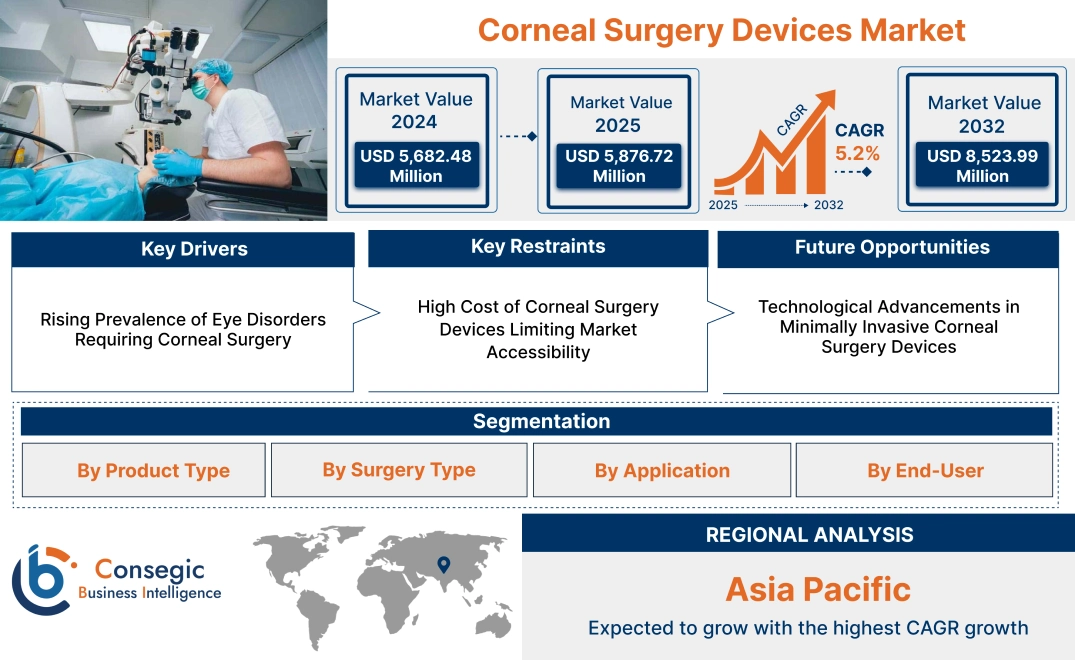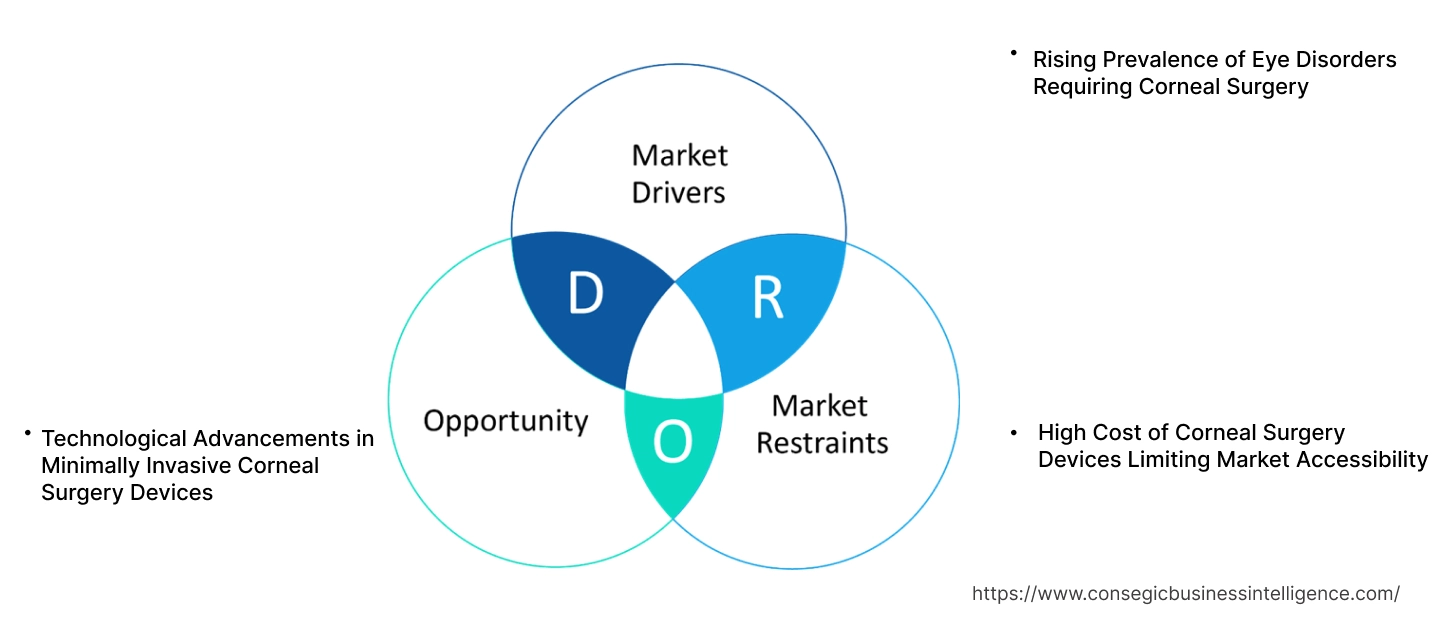Corneal Surgery Devices Market Size:
Corneal Surgery Devices Market size is estimated to reach over USD 8,523.99 Million by 2032 from a value of USD 5,682.48 Million in 2024 and is projected to grow by USD 5,876.72 Million in 2025, growing at a CAGR of 5.2% from 2025 to 2032.
Corneal Surgery Devices Market Scope & Overview:
Corneal surgery devices are specialized instruments designed to treat corneal disorders, improve vision, and restore eye health. These devices are crucial in procedures like corneal transplantation, laser eye surgery, and keratoplasty. Key features include precision control, advanced imaging, and safety mechanisms to minimize tissue damage. Benefits include enhanced accuracy, reduced recovery time, and improved patient outcomes.
Applications span across hospitals, specialized eye clinics, and outpatient centers. End-use industries include ophthalmology practices, surgical centers, and research institutions focused on eye health and vision correction. These devices help treat conditions such as cataracts, corneal scarring, and refractive errors.
Key Drivers:
Rising Prevalence of Eye Disorders Requiring Corneal Surgery
The increasing prevalence of eye disorders such as keratoconus, corneal dystrophies, and cataracts drives the trend for corneal surgery devices. These conditions often require surgical interventions to restore vision and improve quality of life. For instance, keratoconus, a condition that causes thinning of the cornea, often necessitates procedures like corneal transplants or cross-linking, leading to the use of specialized corneal surgery devices.
As the global population ages and the incidence of such eye conditions increases, the need for advanced surgical devices, such as femtosecond lasers and corneal transplantation instruments, is expected to expand. Therefore, the growing number of eye disorders that require corneal surgery significantly contributes to the corneal surgery devices market demand for these devices.
Key Restraints:
High Cost of Corneal Surgery Devices Limiting Market Accessibility
The high cost of advanced corneal surgery devices acts as a significant restraint to corneal surgery devices market expansion. Devices like femtosecond lasers, which are essential for precise corneal surgeries, come with hefty price tags, making them inaccessible for many healthcare facilities, especially in low- and middle-income regions. This price barrier limits the widespread adoption of these devices and hinders the overall corneal surgery devices market growth.
Additionally, the ongoing maintenance and training costs associated with these high-tech instruments create further financial challenges for healthcare providers. As a result, the affordability issue impedes the corneal surgery devices market growth, particularly in less developed regions.
Future Opportunities :
Technological Advancements in Minimally Invasive Corneal Surgery Devices
Future advancements in minimally invasive surgical technologies present a significant corneal surgery devices market opportunity. New innovations in laser technology, such as femtosecond lasers, have revolutionized corneal surgery by providing more precise, less invasive procedures with faster recovery times. Additionally, innovations in robotic surgery and enhanced imaging systems are expected to further improve surgical outcomes, making procedures safer and more effective.
As these technologies continue to evolve, the adoption of minimally invasive surgical approaches in corneal surgeries is likely to increase, creating substantial opportunities for corneal surgery devices market trend. Therefore, the development of advanced, less invasive surgical devices will drive significant corneal surgery devices market expansion in the near future.
Corneal Surgery Devices Market Segmental Analysis :
By Product Type:
Based on product type, the corneal surgery devices market is segmented into corneal implants, corneal sutures, corneal forceps, tonometers, corneal scissors, and other surgical instruments.
Corneal Implants accounted for the largest revenue in corneal surgery devices market share in 2024 and is anticipated to register the fastest CAGR during the forecast period.
- Corneal implants are used in the treatment of various corneal diseases such as keratoconus, corneal dystrophies, and corneal scarring. They include both synthetic and biological implants, designed to restore or replace damaged corneal tissue.
- Technological advancements in biomaterials and design have contributed to the increasing adoption of corneal implants. These devices aim to restore normal vision by improving corneal curvature or transparency.
- As an essential component in several corneal surgeries, their growing demand is supported by the increasing prevalence of corneal disorders and rising awareness about eye health.
- Therefore, according to corneal surgery devices market analysis, corneal implants lead the market due to their role in a wide range of surgical applications and their continuous innovation to improve patient outcomes.
By Surgery Type:
Based on surgery type, the market is segmented into penetrating keratoplasty, endothelial keratoplasty, anterior lamellar keratoplasty, phototherapeutic keratectomy (PTK), and other corneal surgeries.
Penetrating Keratoplasty (PKP) accounted for the largest revenue in corneal surgery devices market share in 2024 and is anticipated to register the fastest CAGR during the forecast period.
- Penetrating keratoplasty, also known as a full-thickness corneal transplant, involves replacing a damaged or diseased cornea with a donor cornea. This procedure is typically performed when other less invasive treatments are not effective.
- PKP remains the gold standard for treating severe corneal diseases, including corneal scarring, keratoconus, and Fuchs' dystrophy.
- The increasing prevalence of corneal disorders and growing donor tissue availability contribute to the higher trend for this surgery type.
- Therefore, according to corneal surgery devices market analysis, PKP continues to dominate the market as the most common and established treatment for advanced corneal diseases.
By Application:
Based on application, the corneal surgery devices market is segmented into keratoconus treatment, corneal ulcer repair, Fuchs’ dystrophy treatment, refractive surgery, and trauma repair.
Keratoconus Treatment accounted for the largest revenue share in 2024 and is anticipated to register the fastest CAGR during the forecast period.
- Keratoconus treatment involves the use of corneal implants, cross-linking, and other devices to stabilize and improve the cornea's shape, preventing further progression of the condition.
- The increasing prevalence of keratoconus, especially among young adults, drives the trend for devices and procedures aimed at treating this condition.
- Technological innovations in cross-linking therapies and implantable devices are enhancing treatment outcomes, further propelling the segment's trend.
- Therefore, according to market analysis, Keratoconus treatment continues to be a major focus area in the corneal surgery devices market, supported by rising awareness and advancements in treatment methodologies.
By End User:
Based on end-users, the market is segmented into hospitals, ophthalmic clinics, and ambulatory surgical centers.
Hospitals accounted for the largest revenue share by 42.50% in 2024 and is anticipated to register the fastest CAGR during the forecast period.
- Hospitals serve as the primary setting for corneal surgeries, offering advanced diagnostic and surgical technologies to treat corneal diseases.
- The growing patient base and the ability to offer specialized treatment options contribute to hospitals' dominance in the market. Additionally, hospitals are equipped with the necessary infrastructure to handle complex surgical cases and postoperative care.
- Therefore, according to market analysis, the trend toward specialized ophthalmic surgery centers in hospitals is expected to continue driving the segment’s growth.
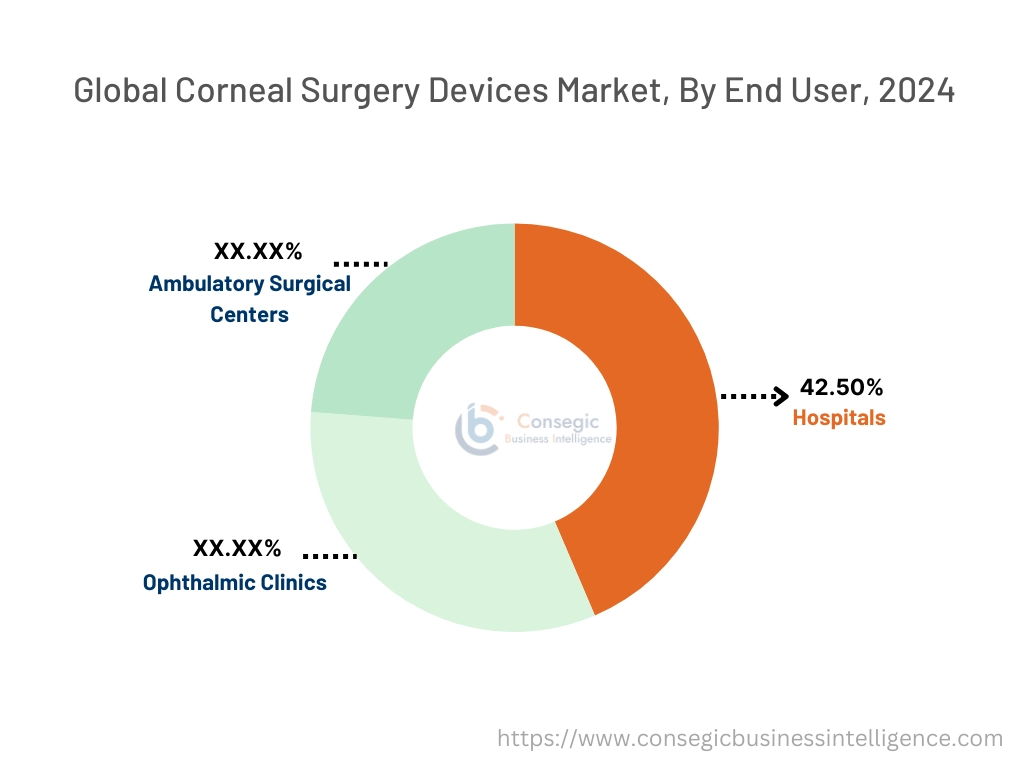
Regional Analysis:
The regional segment includes North America, Europe, Asia Pacific, Middle East and Africa, and Latin America.
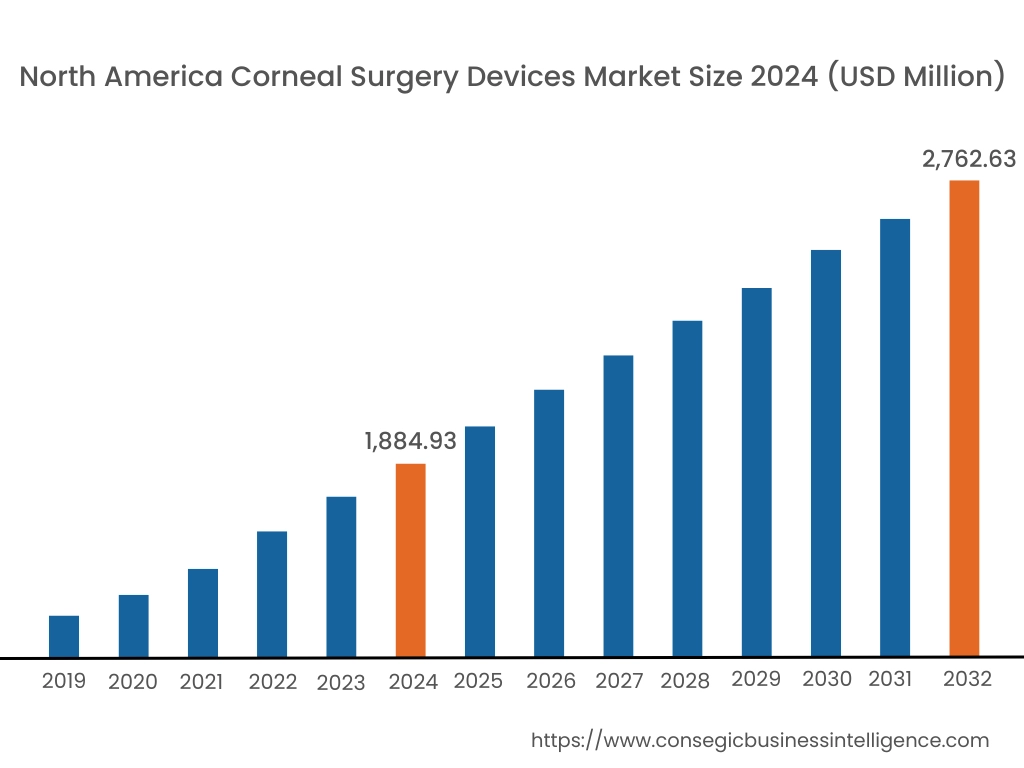
In 2024, North America was valued at USD 1,884.93 Million and is expected to reach USD 2,762.63 Million in 2032. In North America, the U.S. accounted for the highest share of 73.50% during the base year of 2024. The North American region held a significant share in the corneal surgery devices market in 2024. The presence of advanced healthcare infrastructure and high awareness of eye disorders contribute to its dominance. The increasing prevalence of refractive errors, keratoconus, and other corneal diseases drives the trend for specialized surgical devices in the region. Additionally, key market players in the U.S. and Canada invest heavily in research and development to introduce innovative solutions for corneal surgeries. Furthermore, favorable reimbursement policies and high healthcare expenditure in North America further enhance the adoption of corneal surgery devices. The region is expected to maintain its position due to continued advancements in medical technologies and a growing geriatric population.
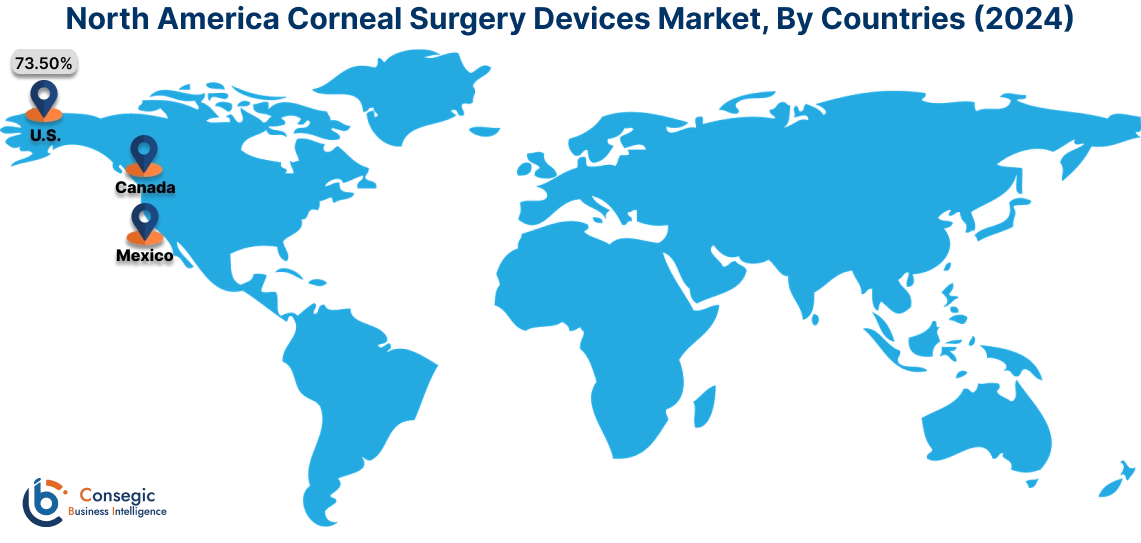
In Asia Pacific, the market is experiencing the fastest growth with a CAGR of 5.6% over the forecast period. Asia-Pacific is anticipated to experience the fastest growth in the corneal surgery devices market during the forecast period. The increasing prevalence of corneal diseases, coupled with improvements in healthcare infrastructure, fuels the demand for advanced surgical devices. Countries like India, China, and Japan are witnessing a rise in the number of ophthalmic surgeries, attributed to an aging population and greater awareness of eye health. Government initiatives to improve healthcare access and rising disposable incomes also contribute to market expansion. Additionally, the region is becoming a hub for medical tourism, especially for eye surgeries, further driving the demand for corneal surgery devices.
Europe is a prominent market for corneal surgery devices, with significant contributions from countries such as Germany, France, the U.K., and Italy. The region is characterized by well-established healthcare systems and a high rate of medical innovations. Rising awareness about vision-related health problems and advancements in corneal surgery techniques are key factors propelling the market. The increasing number of cataract and refractive surgeries, alongside the adoption of minimally invasive technologies, enhances the demand for corneal surgery devices in the region. The presence of major medical device manufacturers and a strong focus on research and development further solidify Europe's position in the market.
The Middle East and Africa (MEA) region holds a smaller share of the corneal surgery devices market but is poised for steady trend. The increasing prevalence of corneal disorders, particularly in countries with rapidly expanding populations like Saudi Arabia, the UAE, and South Africa, is a significant driver. Additionally, the region is witnessing improvements in healthcare infrastructure and an influx of advanced medical technologies. Governments in the MEA region are increasingly focusing on healthcare reforms and modernizing medical facilities, which facilitates the adoption of advanced surgical devices. The growing medical tourism sector, especially for eye care, also contributes to the market's expansion.
In Latin America, the corneal surgery devices market is experiencing moderate growth. The demand for corneal surgeries is rising, primarily due to the increasing awareness of eye diseases and advancements in healthcare facilities. Countries like Brazil, Mexico, and Argentina are witnessing improvements in ophthalmic care, contributing to a higher adoption of corneal surgery devices. Economic development and better access to healthcare in urban areas are key factors leading to the increased demand for specialized devices. Furthermore, the growth of medical tourism, especially for ophthalmic treatments, supports the regional market.
Top Key Players and Market Share Insights:
The Global Corneal Surgery Devices Market is highly competitive with major players providing products and servicesto the national and international markets. Key players are adopting several strategies in research and development (R&D), product innovation, and end-user launches to hold a strong position in the Global Corneal Surgery Devices Market. Key players in the Corneal Surgery Devices industry include-
- Alcon Inc. (Switzerland)
- Abbott Laboratories (United States)
- Ziemer Ophthalmic Systems AG (Switzerland)
- Surgeon Microsystems (United States)
- Lumenis Ltd. (Israel)
- Bausch + Lomb (United States)
- Carl Zeiss AG (Germany)
- Johnson & Johnson Vision (United States)
- Medtronic PLC (Ireland)
- Hoya Corporation (Japan)
Recent Industry Developments:
Product Launches:
- In October 2024, Corza Medical launched the Onatec line of ophthalmic microsurgical sutures at the American Academy of Ophthalmology conference. These sutures are crafted from highly tempered stainless steel, ensuring durability and precise needle geometries for delicate eye surgeries. The advanced manufacturing process results in optimal penetration and reduced tissue trauma, enhancing patient comfort.
Partnerships & Collaborations:
- In July 2024, Johnson & Johnson Vision invested in TECLens through Series. A funding to support the development of a non-incisional refractive correction method. This method utilizes corneal cross-linking (CXL) technology to reshape the cornea, reflecting a commitment to innovative eye care solutions.
Corneal Surgery Devices Market Report Insights :
| Report Attributes | Report Details |
| Study Timeline | 2019-2032 |
| Market Size in 2032 | USD 8,523.99 Million |
| CAGR (2025-2032) | 5.2% |
| By Product Type |
|
| By Surgery Type |
|
| By Application |
|
| By End User |
|
| By Region |
|
| Key Players |
|
| North America | U.S. Canada Mexico |
| Europe | U.K. Germany France Spain Italy Russia Benelux Rest of Europe |
| APAC | China South Korea Japan India Australia ASEAN Rest of Asia-Pacific |
| Middle East and Africa | GCC Turkey South Africa Rest of MEA |
| LATAM | Brazil Argentina Chile Rest of LATAM |
| Report Coverage |
|
Key Questions Answered in the Report
How big is the Corneal Surgery Devices Market? +
In 2024, the Corneal Surgery Devices Market was USD 5,682.48 million.
What will be the potential market valuation for the Corneal Surgery Devices Market by 2032? +
In 2032, the market size of Corneal Surgery Devices Market is expected to reach USD 8,523.99 million.
What are the segments covered in the Corneal Surgery Devices Market report? +
The product type, surgery type, application, and end-user are the segments covered in this report.
Who are the major players in the Corneal Surgery Devices Market? +
Alcon Inc. (Switzerland), Abbott Laboratories (United States), Bausch + Lomb (United States), Carl Zeiss AG (Germany), Johnson & Johnson Vision (United States), Medtronic PLC (Ireland), Hoya Corporation (Japan), Ziemer Ophthalmic Systems AG (Switzerland), Surgeon Microsystems (United States), Lumenis Ltd. (Israel) are the major players in the Corneal Surgery Devices market.
